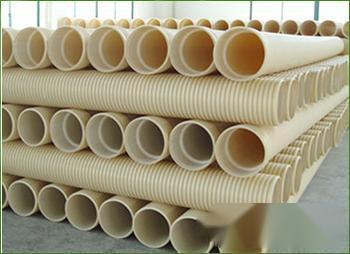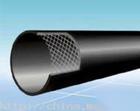Product Content
Category
Construction Materials-Other Building Materials
The PE pipe for water supply is a replacement product for traditional steel pipes and polyvinyl chloride drinking water pipes.
Water supply pipes must withstand certain pressures, so it is usually necessary to select PE resins with high molecular weight and good mechanical properties, such as HDPE resin. LDPE resin has low tensile strength, poor pressure resistance, low rigidity, poor dimensional stability during molding, and is difficult to connect, making it unsuitable as a material for water supply pressure pipes. However, due to its high sanitary standards, LDPE, especially LLDPE resin, has become a commonly used material for producing drinking water pipes. LDPE and LLDPE resins have low melt viscosity, good flowability, and are easy to process, so the selection range for their melt index is also wide, typically between 0.3-3g/10min.
A good pipe should not only have good economic efficiency but also possess a series of advantages such as reliable and stable joints, impact resistance, crack resistance, aging resistance, and corrosion resistance. Compared to traditional piping materials, HDPE piping systems have the following series of advantages:
1. Reliable connections: The polyethylene piping systems are connected using electric heat fusion methods, with joint strength exceeding that of the pipe itself.
2. Good low-temperature impact resistance: The low-temperature embrittlement temperature of polyethylene is very low, allowing for safe use within the temperature range of -60 to 60°C. During winter construction, the material's good impact resistance ensures that the pipes do not become brittle and crack.
3. Good stress crack resistance: HDPE has low notch sensitivity, high shear strength, and excellent scratch resistance, with outstanding performance against environmental stress cracking.
4. Good chemical corrosion resistance: HDPE pipes can withstand the corrosion of various chemical media, and the chemicals present in the soil do not degrade the pipes. Polyethylene is an electrical insulator, so it does not corrode, rust, or undergo electrochemical corrosion; additionally, it does not promote the growth of algae, bacteria, or fungi.
However, harmful substances may be released during combustion.
5. Aging resistance and long service life: Polyethylene pipes containing 2-2.5% uniformly distributed carbon black can be stored or used outdoors for 50 years without damage from ultraviolet radiation.
6. Good wear resistance: Comparative tests of wear resistance between HDPE pipes and steel pipes indicate that the wear resistance of HDPE pipes is four times that of steel pipes. In the field of slurry transport, HDPE pipes exhibit better wear resistance compared to steel pipes, which means they have a longer service life and better economic efficiency.
7. Good flexibility: The flexibility of HDPE pipes makes them easy to bend, allowing for the rerouting of pipes around obstacles in engineering applications. In many cases, the flexibility of the pipes can reduce the amount of fittings required and lower installation costs.
8. Low water flow resistance: HDPE pipes have smooth inner surfaces with a Manning's coefficient of 0.009. The smooth performance and non-adhesive properties ensure that HDPE pipes have higher transport capabilities than traditional piping materials, while also reducing pressure loss in the pipeline and water transport energy consumption.
9. Convenient handling: HDPE pipes are lighter than concrete pipes, galvanized pipes, and steel pipes, making them easy to handle and install. The lower manpower and equipment requirements significantly reduce installation costs.
10. Multiple new construction methods: HDPE pipes can be constructed using various techniques; besides traditional excavation methods, several new non-excavation techniques such as pipe jacking, directional drilling, pipe lining, and pipe bursting can also be employed. This makes HDPE pipes a preferred choice in locations where excavation is not allowed, thus broadening their application fields.
Flexibility: PE-RT is relatively soft, hence no special tools are required during construction, resulting in lower construction costs. 2. Thermal conductivity: Pipes used for floor heating need good thermal conductivity. PE-RT has excellent thermal conductivity, with a thermal conductivity coefficient twice that of PP-R and PP-B pipes. It is ideal for use in floor heating. 3. High-temperature resistance: PE-RT can withstand temperatures up to 90°C, while PEX can only reach 65°C. 4. Low-temperature impact resistance: PE-RT has good low-temperature impact resistance. During winter construction, the pipes are less likely to break due to impact, increasing flexibility in construction arrangements. 5. Environmental friendliness: PE-RT and PP-R can be recycled without polluting the environment, whereas PEX cannot be recycled and can cause secondary pollution. 6. Stable processing performance: PEX has issues related to controlling crosslinking degree and uniformity, making processing complex and directly affecting pipe performance. In contrast, PE-RT and PP-R are easy to process, with performance primarily determined by raw materials, leading to greater stability. PE-RT stands for Polyethylene Raised Temperature, which is a medium-density ethylene-octene copolymer designed specifically for heating systems, featuring narrow molecular weight distribution and uniform distribution of octene on the polymer backbone. It retains the original sanitary and processing advantages of PE while enhancing high-temperature durability.
The product features of HDPE water supply pipes are:
- Good sanitary performance: PE pipes are processed without adding heavy metal salt stabilizers, are non-toxic, do not form scale, and do not breed bacteria, effectively addressing secondary pollution of urban drinking water.
- Excellent corrosion resistance: With the exception of a few strong oxidizers, PE pipes can withstand corrosion from various chemical media; there is no electrochemical corrosion.
- Long service life: Under rated temperature and pressure conditions, PE pipes can be safely used for over 50 years.
- Good impact resistance: PE pipes have good toughness and high impact strength. Heavy objects directly pressed over the pipes do not cause breakage.
- Reliable connection performance: The strength of PE pipe heat fusion or electric fusion joints exceeds that of the pipe body, ensuring that seams do not break due to soil movement or live loads.
- Good construction performance: The pipes are lightweight, with simple welding processes that facilitate construction and lower overall project costs.
Pipe connections include:
- Electric heat fusion: Use a dedicated electric heat fusion welding machine to connect straight pipes with straight pipes or fittings. Generally used for pipes below 160mm.
- Socket fusion connection: Use a dedicated socket welding machine to connect pipes, generally used for pipes above 160mm.
- Steel-plastic connection: Can be connected using flanges, threaded joints, and other methods.
- To facilitate construction and ensure quality, appropriate tools should also be prepared.
For example: a rotary cutter for cutting pipes; a rotary scraper for removing oxidation from pipe surfaces; a wall-climbing scraper for removing oxidation from large diameter pipes; and an air cutoff tool for on-site air cutoff operations.
Connection steps:
1. Clamp and clean the ports.
2. Adjust and smooth the ports.
3. Align the ports.
4. Apply pressure to fuse.
5. Release pressure and cool.
Application fields:
- Urban water supply pipe network systems.
- Urban and rural drinking water pipelines.
- Conveying pipelines for chemicals, chemical fibers, food, forestry, printing and dyeing, pharmaceuticals, light industry, paper making, metallurgy, and other industries.
- Agricultural irrigation pipelines.
- Protective casings for postal and telecommunications lines, electrical wires.
- Mining slurry transport pipelines.
- Protective casings for postal and telecommunications lines, electrical wires.
Advantages of HDPE water supply pipes:
1. High strength, excellent environmental stress crack resistance, and good creep resistance.
2. Good toughness and flexibility, strong adaptability to uneven foundations and misalignment, and resistance to harsh environments such as earthquakes and typhoons.
3. Good weather resistance (including UV resistance) and long-term thermal stability.
4. Corrosion-resistant, requiring no anti-corrosion treatment, with a long service life.
5. Smooth inner walls, low water flow resistance, high flow capacity, and cost savings in construction.
6. Good wear resistance and abrasion resistance.
7. Good low-temperature impact resistance, safe for use within the temperature range of -20 to 40°C, unaffected by winter construction.





